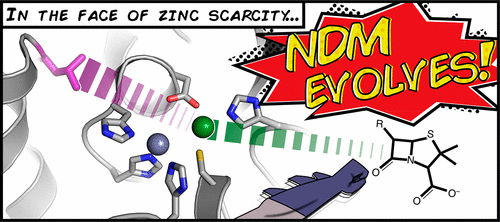当前位置:
X-MOL 学术
›
ACS Infect. Dis.
›
论文详情
Our official English website, www.x-mol.net, welcomes your
feedback! (Note: you will need to create a separate account there.)
Clinical Variants of New Delhi Metallo-β-Lactamase Are Evolving To Overcome Zinc Scarcity
ACS Infectious Diseases ( IF 4.0 ) Pub Date : 2017-10-11 00:00:00 , DOI: 10.1021/acsinfecdis.7b00128 Alesha C. Stewart 1 , Christopher R. Bethel 2 , Jamie VanPelt 3 , Alex Bergstrom 3 , Zishuo Cheng 3 , Callie G. Miller 3 , Cameron Williams 3 , Robert Poth 3 , Matthew Morris 3 , Olivia Lahey 3 , Jay C. Nix 4 , David L. Tierney 3 , Richard C. Page 3 , Michael W. Crowder 3 , Robert A. Bonomo 2, 5 , Walter Fast 1
ACS Infectious Diseases ( IF 4.0 ) Pub Date : 2017-10-11 00:00:00 , DOI: 10.1021/acsinfecdis.7b00128 Alesha C. Stewart 1 , Christopher R. Bethel 2 , Jamie VanPelt 3 , Alex Bergstrom 3 , Zishuo Cheng 3 , Callie G. Miller 3 , Cameron Williams 3 , Robert Poth 3 , Matthew Morris 3 , Olivia Lahey 3 , Jay C. Nix 4 , David L. Tierney 3 , Richard C. Page 3 , Michael W. Crowder 3 , Robert A. Bonomo 2, 5 , Walter Fast 1
Affiliation

|
Use and misuse of antibiotics have driven the evolution of serine β-lactamases to better recognize new generations of β-lactam drugs, but the selective pressures driving evolution of metallo-β-lactamases are less clear. Here, we present evidence that New Delhi metallo-β-lactamase (NDM) is evolving to overcome the selective pressure of zinc(II) scarcity. Studies of NDM-1, NDM-4 (M154L), and NDM-12 (M154L, G222D) demonstrate that the point mutant M154L, contained in 50% of clinical NDM variants, selectively enhances resistance to the penam ampicillin at low zinc(II) concentrations relevant to infection sites. Each of the clinical variants is shown to be progressively more thermostable and to bind zinc(II) more tightly than NDM-1, but a selective enhancement of penam turnover at low zinc(II) concentrations indicates that most of the improvement derives from catalysis rather than stability. X-ray crystallography of NDM-4 and NDM-12, as well as bioinorganic spectroscopy of dizinc(II), zinc(II)/cobalt(II), and dicobalt(II) metalloforms probe the mechanism of enhanced resistance and reveal perturbations of the dinuclear metal cluster that underlie improved catalysis. These studies support the proposal that zinc(II) scarcity, rather than changes in antibiotic structure, is driving the evolution of new NDM variants in clinical settings.
中文翻译:

新德里Metallo-β-内酰胺酶的临床变异正在发展以克服锌缺乏的问题
抗生素的使用和滥用推动了丝氨酸β-内酰胺酶的进化,以更好地识别新一代的β-内酰胺药物,但驱动金属β-内酰胺酶进化的选择性压力尚不清楚。在这里,我们提供的证据表明,新德里金属β-内酰胺酶(NDM)正在发展,以克服锌(II)稀缺性的选择性压力。对NDM-1,NDM-4(M154L)和NDM-12(M154L,G222D)的研究表明,临床NDM变体的50%中包含的点突变体M154L在低锌时选择性增强了对Penam ampicillin的抗性(II) )与感染部位有关的浓度。与NDM-1相比,每种临床变体均显示出越来越稳定的热稳定性,并且与锌(II)的结合更紧密,但是在低锌(II)浓度下戊烷转换的选择性增强表明,大多数改善来自催化而不是稳定性。NDM-4和NDM-12的X射线晶体学分析,以及二锌(II),锌(II)/钴(II)和二钴(II)金属型的生物无机光谱,探讨了增强抗性的机理并揭示了金属的微扰。改善催化作用的双核金属簇。这些研究支持以下建议:锌(II)的稀缺性而不是抗生素结构的变化,正在推动临床环境中新的NDM变体的发展。和二甲双(II)金属型化合物探讨了增强抗性的机理,并揭示了双核金属簇的扰动,这些扰动是改善催化作用的基础。这些研究支持以下建议:锌(II)的稀缺性而不是抗生素结构的变化,正在推动临床环境中新的NDM变体的发展。和二甲双胍(II)金属型探讨了增强抗性的机制,并揭示了双核金属簇的扰动,这些扰动是改善催化作用的基础。这些研究支持以下建议:锌(II)的稀缺性而不是抗生素结构的变化,正在推动临床环境中新的NDM变体的发展。
更新日期:2017-10-11
中文翻译:

新德里Metallo-β-内酰胺酶的临床变异正在发展以克服锌缺乏的问题
抗生素的使用和滥用推动了丝氨酸β-内酰胺酶的进化,以更好地识别新一代的β-内酰胺药物,但驱动金属β-内酰胺酶进化的选择性压力尚不清楚。在这里,我们提供的证据表明,新德里金属β-内酰胺酶(NDM)正在发展,以克服锌(II)稀缺性的选择性压力。对NDM-1,NDM-4(M154L)和NDM-12(M154L,G222D)的研究表明,临床NDM变体的50%中包含的点突变体M154L在低锌时选择性增强了对Penam ampicillin的抗性(II) )与感染部位有关的浓度。与NDM-1相比,每种临床变体均显示出越来越稳定的热稳定性,并且与锌(II)的结合更紧密,但是在低锌(II)浓度下戊烷转换的选择性增强表明,大多数改善来自催化而不是稳定性。NDM-4和NDM-12的X射线晶体学分析,以及二锌(II),锌(II)/钴(II)和二钴(II)金属型的生物无机光谱,探讨了增强抗性的机理并揭示了金属的微扰。改善催化作用的双核金属簇。这些研究支持以下建议:锌(II)的稀缺性而不是抗生素结构的变化,正在推动临床环境中新的NDM变体的发展。和二甲双(II)金属型化合物探讨了增强抗性的机理,并揭示了双核金属簇的扰动,这些扰动是改善催化作用的基础。这些研究支持以下建议:锌(II)的稀缺性而不是抗生素结构的变化,正在推动临床环境中新的NDM变体的发展。和二甲双胍(II)金属型探讨了增强抗性的机制,并揭示了双核金属簇的扰动,这些扰动是改善催化作用的基础。这些研究支持以下建议:锌(II)的稀缺性而不是抗生素结构的变化,正在推动临床环境中新的NDM变体的发展。











































 京公网安备 11010802027423号
京公网安备 11010802027423号